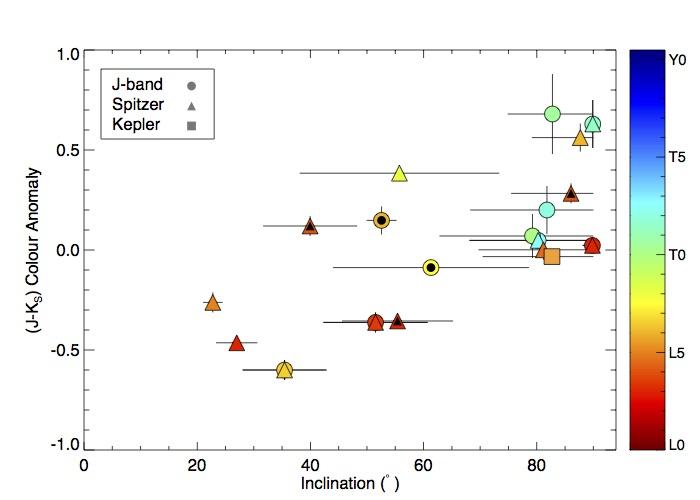The Viewing Geometry of Brown Dwarfs Influences Their Spectral Appearance
Researchers at the Centre for Exoplanet Science investigated the effects of viewing geometry on the observed properties of brown dwarfs.
In a new paper (Vos et al. 2017) researchers at the Centre for Exoplanet Science investigated the effects of viewing geometry on the observed properties of brown dwarfs. Brown dwarfs can be thought of as ‘failed stars’ since they form like stars, in a molecular cloud of gas and dust, however they do not gather the mass needed to sustain hydrogen burning in their cores. They are born hot and spend their lives cooling and dimming. Brown dwarfs share similar temperatures and pressures with directly imaged planets but are much easier to observe, so they can provide insight into exoplanet atmospheres.

At temperatures, of ~2100 K, clouds of molten iron and silicate form in the atmospheres of brown dwarfs. These clouds appear dark on the surface of the brown dwarf and we can detect them as they rotate in and out of view, with a technique known as photometric variability monitoring. Using archival and literature data the team constrained the inclination angles of a sample of photometrically variable brown dwarfs and identified trends relating to viewing angle, variability amplitude and near-infrared color. The results confirm that the inclination angle of a brown dwarf influences the observed variability amplitude, with the highest variability amplitudes occurring for brown dwarfs that are viewed equator-on. None of the variable brown dwarfs in the sample are pole-on, suggesting that such the observed variability is strongly attenuated for pole-on objects.
The team also identified a trend relating the color of a brown dwarf to its inclination angle. The figure shows the inclination angle of each brown dwarf in the sample plotted against its color anomaly. The colour anomaly of a brown dwarf is the difference in color from the median color for its spectral type and gravity class. A brown dwarf with a positive color anomaly has colors that are redder than the median while a brown dwarf with a negative color anomaly is bluer than the median. The figure shows that objects viewed pole-on (with low inclination angles) appear bluer than the median whereas objects that are viewed equator-on (with inclination angles close to 90 degrees) appear redder than the median. This figure indicates that the spectral appearance of a brown dwarf may be determined by its viewing angle. This could occur if clouds are not homogeneously distributed in latitude or if grain size and/or cloud thickness vary in latitude. The results can be explained if thicker or large-grained clouds are situated at the equator, with thinner or small-grained clouds situated at the poles.
Links:
Vos, J.M., Allers, K.N., Biller, B.A., The Viewing Geometry of Brown Dwarfs Influences Their Observed Colors and Variability Amplitudes, The Astrophysical Journal, 842, article id. 72

